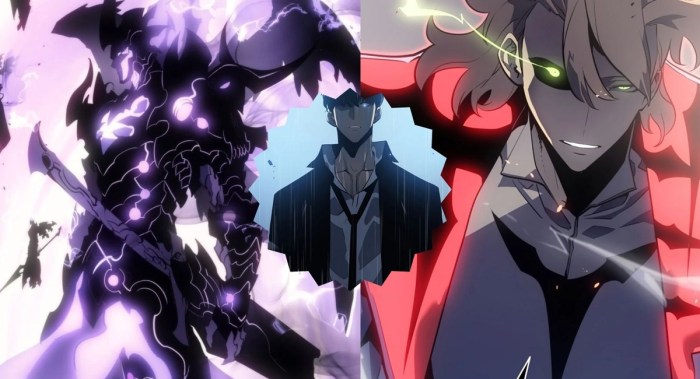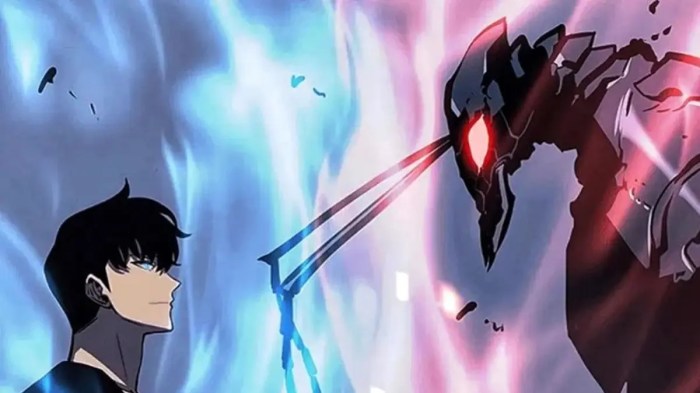Solo Leveling’s Gameplay Mechanics
Solo Leveling’s combat system draws inspiration from Soulslike games, emphasizing player skill and strategic thinking. It presents a challenging yet rewarding gameplay experience, demanding players to master their abilities and adapt to the game’s dynamic environments.
Combat System
The combat system in Solo Leveling mirrors Soulslike games, requiring players to carefully manage their stamina and execute precise attacks to defeat enemies. Players must learn enemy attack patterns, dodge effectively, and utilize their skills strategically to gain an advantage. The game’s combat system prioritizes skill over brute force, rewarding players who master its intricacies.
Difficulty Levels
The difficulty levels in Solo Leveling and Soulslike games share similarities, both presenting a challenging experience that requires dedication and perseverance. Both game genres often feature punishing environments and formidable enemies that require strategic thinking and precise execution. However, Solo Leveling might offer a more accessible entry point for players new to Soulslike games, while still maintaining a core level of difficulty.
Player Death
Player death in Solo Leveling serves a significant purpose, mirroring the mechanics of Soulslike games. Upon death, players lose a portion of their accumulated experience points, which can be retrieved by returning to the location of their demise. This mechanic encourages careful play and discourages reckless aggression, emphasizing the value of strategic decision-making. The loss of experience points serves as a penalty for failure, incentivizing players to learn from their mistakes and improve their skills.
World Design and Exploration: Is Solo Leveling Arise Soulslike
The world of Solo Leveling, like Soulslike games, offers a captivating experience through its intricate world design and exploration. The interconnectedness of areas, hidden paths, and the constant sense of discovery contribute to a rich and rewarding gameplay experience. While Solo Leveling doesn’t present a vast open world like Elden Ring, its meticulously crafted environments and hidden secrets offer a similar sense of exploration and discovery.
Environmental Storytelling
Environmental storytelling is a key aspect of both Solo Leveling and Soulslike games. The environments themselves are designed to convey the world’s history, atmosphere, and lore without relying solely on dialogue or exposition. In Solo Leveling, the desolate and abandoned cities, ravaged by the onslaught of monsters, serve as a stark reminder of the world’s struggle against the Gates. Similarly, in Soulslike games, the dilapidated castles, overgrown ruins, and haunting landscapes provide clues to the events that led to the current state of the world.
- In Solo Leveling, the abandoned city of Seoul, filled with remnants of past battles and decaying buildings, serves as a poignant reminder of the devastation caused by the Gates. The sense of isolation and despair is palpable, contributing to the world’s atmosphere.
- In Soulslike games, environments like Anor Londo in Dark Souls, with its crumbling architecture and ethereal atmosphere, tell a story of a once-great civilization that has fallen into ruin. The sense of grandeur and decay combined with the haunting soundtrack creates a memorable experience.
Similarities with Soulslike Games
Several environments in Solo Leveling share similarities with Soulslike games, showcasing their aesthetic and gameplay influences. The design of dungeons, boss arenas, and even the overall layout of certain areas echo the design principles found in popular Soulslike games.
- The dungeon in the first Gate, where Sung Jin-woo faces off against the first boss, resembles a dark and claustrophobic dungeon in a Soulslike game. The narrow corridors, hidden traps, and challenging enemies create a tense and rewarding experience.
- The final battle against the Monarch, where Sung Jin-woo confronts the powerful creature in a vast and open arena, echoes the design of boss arenas in Soulslike games. The expansive space allows for a variety of combat strategies and tactics, making the encounter even more thrilling.
Character Development and Progression
Solo Leveling’s character progression system is a blend of traditional RPG elements and the unique abilities of its world. It allows players to build characters with diverse strengths and weaknesses, offering a dynamic and engaging gameplay experience. The system encourages experimentation and customization, allowing players to forge their own path in this challenging world.
Character Customization Options
The character customization options in Solo Leveling offer a compelling blend of traditional RPG mechanics and the unique features of the game’s world. Players can choose from various classes, each with its own strengths and weaknesses, and further customize their characters through a deep skill tree system. This system allows players to specialize their characters in various ways, catering to different playstyles and preferences.
Solo Leveling’s character customization options provide players with a high degree of freedom, allowing them to craft unique characters that reflect their preferred playstyle.
Skill Tree System
The skill tree system in Solo Leveling is a core element of character development, providing players with a wide array of abilities to learn and master. Each class has its own unique skill tree, offering a diverse range of skills that can be customized to fit different playstyles. The skill tree is divided into various branches, each focusing on a specific aspect of gameplay, such as damage output, defense, or utility.
- Damage Output: This branch focuses on enhancing a character’s offensive capabilities, offering skills that increase damage dealt, critical hit chance, and other offensive bonuses.
- Defense: This branch focuses on improving a character’s defensive capabilities, offering skills that increase armor, health regeneration, and other defensive bonuses.
- Utility: This branch focuses on enhancing a character’s support abilities, offering skills that provide buffs, debuffs, and other utility effects.
Specialization Examples, Is solo leveling arise soulslike
Players can specialize their characters in various ways depending on their preferred playstyle. For example, a player who enjoys aggressive combat could specialize their character in damage output, maximizing their offensive potential. On the other hand, a player who prefers a more defensive approach could specialize their character in defense, making them a resilient force on the battlefield.
- Damage Dealer: This build focuses on maximizing damage output, utilizing skills that increase damage dealt, critical hit chance, and other offensive bonuses. This build is ideal for players who enjoy aggressive combat and taking down enemies quickly.
- Tank: This build focuses on maximizing defense, utilizing skills that increase armor, health regeneration, and other defensive bonuses. This build is ideal for players who prefer a more defensive approach, acting as a shield for their team.
- Support: This build focuses on enhancing support abilities, utilizing skills that provide buffs, debuffs, and other utility effects. This build is ideal for players who enjoy playing a supportive role, aiding their team in combat.
Boss Encounters and Challenges

Solo Leveling’s boss encounters are the pinnacle of the game’s challenge, pushing players to their limits and rewarding them with valuable loot and character progression. These encounters are meticulously designed, blending elements of strategy, skill, and knowledge of the game’s mechanics to create truly memorable experiences.
Comparison to Soulslike Games
The boss fights in Solo Leveling share a striking resemblance to those found in Soulslike games, both in their demanding nature and the emphasis on learning enemy patterns and exploiting weaknesses.
- Emphasis on Player Skill and Knowledge: Both Solo Leveling and Soulslike games demand that players learn enemy attack patterns, timing, and weaknesses to succeed. The game doesn’t simply throw overwhelming power at the player; instead, it rewards careful observation, strategic positioning, and precise execution.
- Punishing but Fair Difficulty: The difficulty in both game types is often described as “punishing but fair.” This means that while death is a common occurrence, it’s not a result of unfair mechanics or cheap attacks. Players are encouraged to learn from their mistakes and adapt their strategies to overcome the challenges.
- Rewarding Exploration and Experimentation: Both game types encourage exploration and experimentation. Discovering hidden paths, secrets, and alternate strategies can often lead to significant advantages in boss encounters. This encourages players to engage with the game’s world and mechanics in a deeper way.
Boss Encounter Design
Solo Leveling’s boss encounters are carefully crafted to test players’ skills and understanding of the game’s mechanics. Each boss possesses unique abilities, attack patterns, and weaknesses that require players to adapt their strategies accordingly.
- Unique Mechanics and Abilities: Each boss in Solo Leveling has a distinct set of abilities and mechanics that players must learn and adapt to. This prevents boss encounters from feeling repetitive and encourages players to think critically about their approach.
- Strategic Demands and Punishing Attacks: Boss encounters often require players to utilize their skills and knowledge to avoid devastating attacks, exploit weaknesses, and utilize the environment to their advantage. These encounters test players’ ability to react quickly, make calculated decisions, and adapt to changing situations.
- Rewarding Challenges: Defeating a boss in Solo Leveling is a rewarding experience. Players are often rewarded with valuable loot, experience points, and access to new areas and content. This reinforces the sense of accomplishment and encourages players to continue pushing their limits.
Boss Comparison Table
The following table compares three prominent bosses from Solo Leveling and three from Soulslike games, highlighting their distinctive features and gameplay elements:
| Game | Boss | Distinctive Features | Gameplay Elements |
|---|---|---|---|
| Solo Leveling | The Monarch of the Dead | Massive size, overwhelming power, multiple phases, utilizes environmental hazards | Requires careful positioning, strategic use of abilities, exploiting weaknesses in each phase |
| Solo Leveling | The Shadow King | High mobility, unpredictable attacks, ability to teleport and summon minions | Requires quick reflexes, understanding of attack patterns, and effective use of crowd control abilities |
| Solo Leveling | The Ancient Dragon | Immense firepower, breath attacks, resistant to conventional damage | Requires knowledge of elemental weaknesses, strategic positioning, and utilizing specific skills to exploit weaknesses |
| Soulslike Games | O&S (Dark Souls) | Two bosses with distinct abilities, one agile and the other powerful, require coordinated attacks | Requires careful positioning, understanding of attack patterns, and utilizing specific skills to exploit weaknesses |
| Soulslike Games | Gwyn, Lord of Cinder (Dark Souls) | Highly mobile, utilizes fire attacks, vulnerable to specific weapon types | Requires careful positioning, timing, and understanding of attack patterns, utilizing specific skills to exploit weaknesses |
| Soulslike Games | Isshin, the Sword Saint (Sekiro: Shadows Die Twice) | Highly aggressive, uses a variety of attacks, requires precise timing and reflexes | Requires mastery of parrying, understanding of attack patterns, and utilizing specific skills to exploit weaknesses |
The Role of Player Death and Difficulty

In Solo Leveling, death is not merely a game over screen but a significant mechanic that shapes the player’s progression, resource management, and overall experience. It acts as a constant reminder of the danger lurking in the shadows, demanding careful strategy and resource allocation. This approach to difficulty, though demanding, adds depth and complexity to the gameplay, creating a compelling and rewarding experience.
Comparison of Difficulty in Solo Leveling and Soulslike Games
Solo Leveling and Soulslike games share a common thread in their approach to difficulty, emphasizing challenge and player skill. However, they differ in their implementation and balance between challenge and accessibility.
- Solo Leveling embraces a more forgiving approach to death. While it punishes players for falling in battle, the consequences are less severe compared to Soulslike games. Players retain a significant portion of their acquired resources, ensuring they can continue progressing without being completely set back. This encourages experimentation and risk-taking, allowing players to learn from their mistakes without feeling overly punished.
- Soulslike games, on the other hand, are renowned for their unforgiving nature. Death often results in a substantial loss of resources and progress, forcing players to carefully strategize and manage their resources. This creates a high-stakes atmosphere where every encounter carries weight and emphasizes the importance of mastering the game’s mechanics.
Challenges Faced by Players in Solo Leveling
The challenges faced by players in Solo Leveling are multifaceted, encompassing various aspects of the gameplay:
| Type of Challenge | Description | Example |
|---|---|---|
| Enemy Encounters | Players encounter a wide variety of enemies, each with unique abilities and weaknesses. | A pack of Shadow Beasts might ambush the player, requiring them to utilize their skills and abilities to outmaneuver and defeat them. |
| Environmental Hazards | The game world is filled with dangerous environments that can pose a significant threat to players. | A collapsing tunnel might trap the player, forcing them to find a way out before the structure collapses entirely. |
| Boss Fights | Boss encounters are the pinnacle of challenge in Solo Leveling, requiring players to master their skills and strategize to defeat these powerful adversaries. | A powerful Shadow Lord might test the player’s limits, forcing them to learn its attack patterns and exploit its weaknesses to emerge victorious. |
Is solo leveling arise soulslike – In conclusion, while Solo Leveling may not be a Soulslike in the traditional sense, its shared gameplay mechanics, world design, and character progression systems create a compelling experience that appeals to fans of both genres. The game’s emphasis on player skill, strategic combat, and the impact of death on progression creates a unique blend of familiar and fresh elements that keeps players on the edge of their seats. Whether you’re a seasoned Soulslike veteran or a newcomer to the genre, Solo Leveling offers a rewarding and challenging gaming experience that is sure to leave a lasting impression.
Solo Leveling’s brutal difficulty and emphasis on grinding for power might make you think of a Soulslike game, but the story’s focus on teamwork and camaraderie reminds us of the shared experience of veterans coming together in games like Call of Duty: Modern Warfare 3’s Warzone. Just like the U Assist Veterans event , Solo Leveling shows how even the toughest challenges can be overcome with a little help from your friends.
And, hey, maybe that’s why we love both: the feeling of accomplishment after facing the impossible, together.



